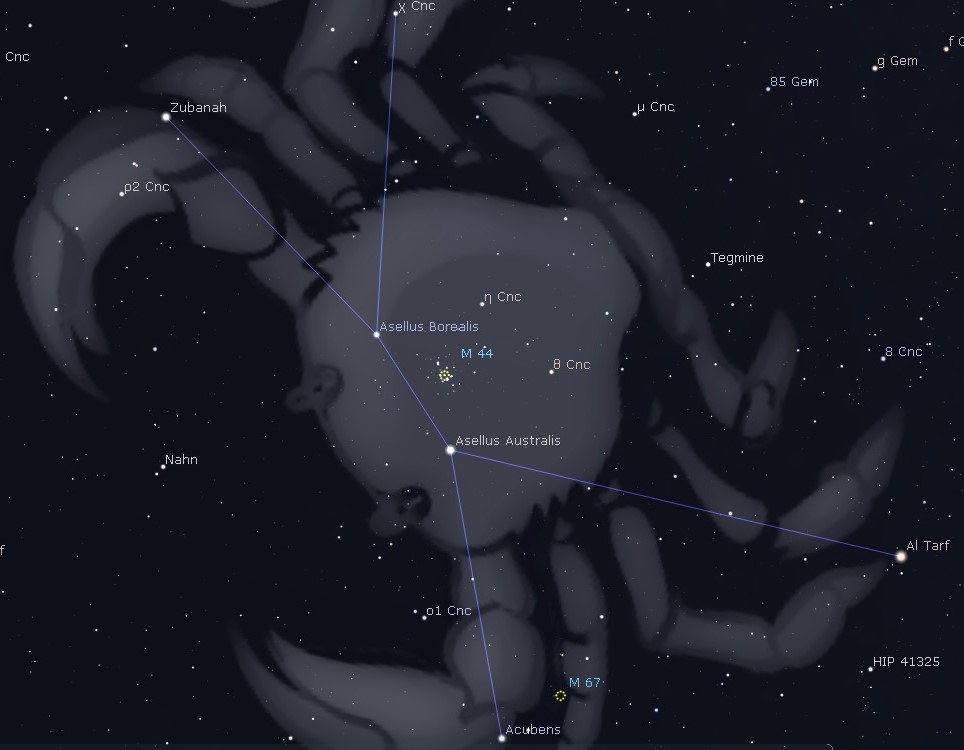This Week’s Sky at a Glance, 2020 February 8 – February 15
~by Curt Nason
The most inconspicuous of the zodiac constellations is faint Cancer the Crab, which is nestled between Gemini and Leo. In mythology, the crab was sent by the goddess queen Hera to distract Hercules while he was battling the Hydra. The crab was no match for the strongman’s stomp. Ancient Egyptians saw it as their sacred dung beetle, the scarab. In the first millennium BC the Sun was in Cancer at the summer solstice, the time when it halts its northward motion and slowly starts heading south. This back and forth motion of the rising and setting Sun on the horizon was perhaps reminiscent of a crab sidling on a beach. The summer Sun is now situated above the foot of Castor in Gemini.
Cancer is recognized by a trapezoid of dim naked eye stars as the crab’s body, with a couple of other stars representing the claws. The four stars were also seen as a manger flanked by a pair of donkeys, Asellus Borealis and Asellus Australus. On a clear dark night we can see a hazy patch of hay within the manger, and binoculars reveal it as a beautiful star cluster called the Beehive, Praesepe or M44. Being near the ecliptic, the planets often pass through or near this cluster, masquerading as a bright guest star. The Beehive was once used to forecast storms, for if it could not be seen it was hidden by light clouds at the front of a weather system. Binoculars can reveal another star cluster, number 67 on the Messier list of fuzzy non-comets, less than a fist-width south of M44.
This Week in the Solar System
Saturday’s sunrise in Moncton is at 7:33 am and sunset will occur at 5:34 pm, giving 10 hours, 1 minute of daylight (7:36 am and 5:40 pm in Saint John). Next Saturday the Sun will rise at 7:22 am and set at 5:44 pm, giving 10 hours, 22 minutes of daylight (7:26 am and 5:51 pm in Saint John).
The Moon is full on Sunday morning and at perigee on Monday, resulting in high tides early in the week. Mercury is at its greatest elongation from the Sun on Monday; sitting a hand span below and right of Venus, which sets two hours later at 9:20 pm. Mars, Jupiter and Saturn are stretched along the ecliptic from south to east in the morning, with Mars zipping toward Jupiter and Jupiter edging toward Saturn. By April, Mars will have passed both. Starting Tuesday and for the next two weeks, the subtle glow of dust reflecting sunlight along the ecliptic can be seen in rural locations beginning an hour after sunset. The zodiacal light forms an angled wedge, and this year Venus is in the middle of it.
The annual INP Moonlight Snowshoe Hike and Observing starts at 7 pm on February 8 at the Sheldon Point barn in Saint John. The William Brydone Jack Astronomy Club meets in the UNB Fredericton Forestry-Earth Sciences building on Tuesday at 7 pm, and RASC NB meets in the same location on February 15 at 1 pm. All are welcome.
Questions? Contact Curt Nason.

